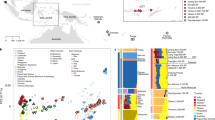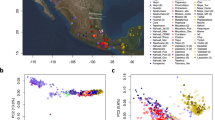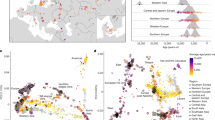Abstract
The indigenous populations of inner Eurasia—a huge geographic region covering the central Eurasian steppe and the northern Eurasian taiga and tundra—harbour tremendous diversity in their genes, cultures and languages. In this study, we report novel genome-wide data for 763 individuals from Armenia, Georgia, Kazakhstan, Moldova, Mongolia, Russia, Tajikistan, Ukraine and Uzbekistan. We furthermore report additional damage-reduced genome-wide data of two previously published individuals from the Eneolithic Botai culture in Kazakhstan (~5,400 bp). We find that present-day inner Eurasian populations are structured into three distinct admixture clines stretching between various western and eastern Eurasian ancestries, mirroring geography. The Botai and more recent ancient genomes from Siberia show a decrease in contributions from so-called ‘ancient North Eurasian’ ancestry over time, which is detectable only in the northern-most ‘forest-tundra’ cline. The intermediate ‘steppe-forest’ cline descends from the Late Bronze Age steppe ancestries, while the ‘southern steppe’ cline further to the south shows a strong West/South Asian influence. Ancient genomes suggest a northward spread of the southern steppe cline in Central Asia during the first millennium bc. Finally, the genetic structure of Caucasus populations highlights a role of the Caucasus Mountains as a barrier to gene flow and suggests a post-Neolithic gene flow into North Caucasus populations from the steppe.
This is a preview of subscription content, access via your institution
Access options
Access Nature and 54 other Nature Portfolio journals
Get Nature+, our best-value online-access subscription
$29.99 / 30 days
cancel any time
Subscribe to this journal
Receive 12 digital issues and online access to articles
$119.00 per year
only $9.92 per issue
Buy this article
- Purchase on Springer Link
- Instant access to full article PDF
Prices may be subject to local taxes which are calculated during checkout





Similar content being viewed by others
Data availability
Genome-wide sequence data of two Botai individuals (BAM format) are available at the European Nucleotide Archive under the accession number PRJEB31152 (ERP113669). Eigenstrat-format array genotype data of 763 present-day individuals and 1,240 K pulldown genotype data of two ancient Botai individuals are available at the Edmond data repository of the Max Planck Society (https://edmond.mpdl.mpg.de/imeji/collection/Aoh9c69DscnxSNjm?q=).
References
Li, J. Z. et al. Worldwide human relationships inferred from genome-wide patterns of variation. Science 319, 1100–1104 (2008).
Wang, C., Zöllner, S. & Rosenberg, N. A. A quantitative comparison of the similarity between genes and geography in worldwide human populations. PLoS Genet. 8, e1002886 (2012).
Jeong, C. et al. Long-term genetic stability and a high altitude East Asian origin for the peoples of the high valleys of the Himalayan arc. Proc. Natl Acad. Sci. USA 113, 7485–7490 (2016).
Yunusbayev, B. et al The Caucasus as an asymmetric semipermeable barrier to ancient human migrations. Mol. Biol. Evol. 29, 359–365 (2012).
Haak, W. et al. Massive migration from the steppe was a source for Indo-European languages in Europe. Nature 522, 207–211 (2015).
Haber, M. et al. Genome-wide diversity in the Levant reveals recent structuring by culture. PLoS Genet. 9, e1003316 (2013).
Martiniano, R. et al. The population genomics of archaeological transition in west Iberia: investigation of ancient substructure using imputation and haplotype-based methods. PLoS Genet. 13, e1006852 (2017).
Allentoft, M. E. et al. Population genomics of Bronze Age Eurasia. Nature 522, 167–172 (2015).
Barfield, T. J. The Nomadic Alternative (Prentice Hall, 1993).
Frachetti, M. D. Pastoralist Landscapes and Social Interaction in Bronze Age Eurasia (Univ. California Press, 2009).
Burch, E. S. The caribou/wild reindeer as a human resource. Am. Antiq. 37, 339–368 (1972).
Sherratt, A. The secondary exploitation of animals in the Old World. World Archaeol. 15, 90–104 (1983).
Yunusbayev, B. et al. The genetic legacy of the expansion of Turkic-speaking nomads across Eurasia. PLoS Genet. 11, e1005068 (2015).
Hellenthal, G. et al. A genetic atlas of human admixture history. Science 343, 747–751 (2014).
Flegontov, P. et al. Genomic study of the Ket: a Paleo-Eskimo-related ethnic group with significant ancient North Eurasian ancestry. Sci. Rep. 6, 20768 (2016).
Pugach, I. et al. The complex admixture history and recent southern origins of Siberian populations. Mol. Biol. Evol. 33, 1777–1795 (2016).
Triska, P. et al. Between Lake Baikal and the Baltic Sea: genomic history of the gateway to Europe. BMC Genet. 18, 110 (2017).
Tambets, K. et al. Genes reveal traces of common recent demographic history for most of the Uralic-speaking populations. Genome Biol. 19, 139 (2018).
Raghavan, M. et al. Upper Palaeolithic Siberian genome reveals dual ancestry of Native Americans. Nature 505, 87–91 (2014).
Lazaridis, I. et al. Genomic insights into the origin of farming in the ancient Near East. Nature 536, 419–424 (2016).
Mathieson, I. et al. Genome-wide patterns of selection in 230 ancient Eurasians. Nature 528, 499–503 (2015).
Damgaard, Pd. B. et al. 137 ancient human genomes from across the Eurasian steppes. Nature 557, 369–374 (2018).
Damgaard, Pd. B. et al. The first horse herders and the impact of early Bronze Age steppe expansions into Asia. Science 360, eaar7711 (2018).
Levine, M. & Kislenko, A. New Eneolithic and early Bronze Age radiocarbon dates for north Kazakhstan and south Siberia. Camb. Archaeol. 7, 297–300 (1997).
Flegontov, P. et al. Paleo-Eskimo genetic legacy across North America. Preprint at https://www.biorxiv.org/content/10.1101/203018v1 (2017).
Mallick, S. et al. The Simons Genome Diversity Project: 300 genomes from 142 diverse populations. Nature 538, 201–206 (2016).
Fu, Q. et al. Genome sequence of a 45,000-year-old modern human from western Siberia. Nature 514, 445–449 (2014).
Fu, Q. et al. The genetic history of Ice Age Europe. Nature 534, 200–205 (2016).
Haber, M. et al. Continuity and admixture in the last five millennia of Levantine history from ancient Canaanite and present-day Lebanese genome sequences. Am. J. Hum. Genet. 101, 274–282 (2017).
Jones, E. R. et al. Upper Palaeolithic genomes reveal deep roots of modern Eurasians. Nat. Commun. 6, 8912 (2015).
Lazaridis, I. et al. Ancient human genomes suggest three ancestral populations for present-day Europeans. Nature 513, 409–413 (2014).
Lazaridis, I. et al. Genetic origins of the Minoans and Mycenaeans. Nature 548, 214–218 (2017).
Raghavan, M. et al. The genetic prehistory of the New World Arctic. Science 345, 1255832 (2014).
Rasmussen, M. et al. The genome of a Late Pleistocene human from a Clovis burial site in western Montana. Nature 506, 225–229 (2014).
Rasmussen, M. et al. Ancient human genome sequence of an extinct Palaeo-Eskimo. Nature 463, 757–762 (2010).
Rasmussen, M. et al. The ancestry and affiliations of Kennewick Man. Nature 523, 455–458 (2015).
Saag, L. et al. Extensive farming in Estonia started through a sex-biased migration from the Steppe. Curr. Biol. 27, 2185–2193 (2017).
Siska, V. et al. Genome-wide data from two early Neolithic East Asian individuals dating to 7700 years ago. Sci. Adv. 3, e1601877 (2017).
Unterländer, M. et al. Ancestry and demography and descendants of Iron Age nomads of the Eurasian Steppe. Nat. Commun. 8, 14615 (2017).
Yang, M. A. et al. 40,000-year-old individual from Asia provides insight into early population structure in Eurasia. Curr. Biol. 27, 3202–3208 (2017).
Kılınç, G. M. et al. The demographic development of the first farmers in Anatolia. Curr. Biol. 26, 2659–2666 (2016).
McColl, H. et al. The prehistoric peopling of Southeast Asia. Science 361, 88–92 (2018).
Patterson, N. et al. Ancient admixture in human history. Genetics 192, 1065–1093 (2012).
Petkova, D., Novembre, J. & Stephens, M. Visualizing spatial population structure with estimated effective migration surfaces. Nat. Genet. 48, 94–100 (2016).
Fenner, J. N. Cross‐cultural estimation of the human generation interval for use in genetics‐based population divergence studies. Am. J. Phys. Anthropol. 128, 415–423 (2005).
Narasimhan, V. M. et al. The genomic formation of South and Central Asia. Preprint at https://www.biorxiv.org/content/10.1101/292581v1 (2018).
Dabney, J. et al. Complete mitochondrial genome sequence of a Middle Pleistocene cave bear reconstructed from ultrashort DNA fragments. Proc. Natl Acad. Sci. USA 110, 15758–15763 (2013).
Rohland, N., Harney, E., Mallick, S., Nordenfelt, S. & Reich, D. Partial uracil–DNA–glycosylase treatment for screening of ancient DNA. Phil. Trans. R. Soc. B 370, 20130624 (2015).
Kircher, M. in Ancient DNA: Methods and Protocols (eds Shapiro, B. & Hofreiter, M.) 197–228 (Humana Press, 2012).
Peltzer, A. et al. EAGER: efficient ancient genome reconstruction. Genome Biol. 17, 60 (2016).
Schubert, M., Lindgreen, S. & Orlando, L. AdapterRemoval v2: rapid adapter trimming, identification, and read merging. BMC Res. Notes 9, 88 (2016).
Li, H. & Durbin, R. Fast and accurate short read alignment with Burrows–Wheeler transform. Bioinformatics 25, 1754–1760 (2009).
Li, H. et al. The sequence alignment/map format and SAMtools. Bioinformatics 25, 2078–2079 (2009).
Jónsson, H., Ginolhac, A., Schubert, M., Johnson, P. L. & Orlando, L. mapDamage2.0: fast approximate Bayesian estimates of ancient DNA damage parameters. Bioinformatics 29, 1682–1684 (2013).
Renaud, G., Slon, V., Duggan, A. T. & Kelso, J. Schmutzi: estimation of contamination and endogenous mitochondrial consensus calling for ancient DNA. Genome Biol. 16, 224 (2015).
Korneliussen, T. S., Albrechtsen, A. & Nielsen, R. ANGSD: analysis of next generation sequencing data. BMC Bioinformatics 15, 356 (2014).
Jun, G., Wing, M. K., Abecasis, G. R. & Kang, H. M. An efficient and scalable analysis framework for variant extraction and refinement from population-scale DNA sequence data. Genome Res. 25, 918–925 (2015).
Weissensteiner, H. et al. HaploGrep 2: mitochondrial haplogroup classification in the era of high-throughput sequencing. Nucleic Acids Res. 44, W58–W63 (2016).
Poznik, G. D. Identifying Y-chromosome haplogroups in arbitrarily large samples of sequenced or genotyped men. Preprint at https://www.biorxiv.org/content/10.1101/088716v1 (2016).
Balanovsky, O. et al. Parallel evolution of genes and languages in the Caucasus region. Mol. Biol. Evol. 28, 2905–2920 (2011).
Koshel, S. in Sovremennaya Geograficheskaya Kartografiya (Modern Geographic Cartography) (eds Lourie, I. & Kravtsova, V.) 158–166 (Data+, 2012).
Patterson, N., Price, A. L. & Reich, D. Population structure and eigenanalysis. PLoS Genet. 2, e190 (2006).
Alexander, D. H., Novembre, J. & Lange, K. Fast model-based estimation of ancestry in unrelated individuals. Genome Res. 19, 1655–1664 (2009).
Chang, C. C. et al. Second-generation PLINK: rising to the challenge of larger and richer datasets. Gigascience 4, 7 (2015).
Reich, D. et al. Reconstructing native American population history. Nature 488, 370–374 (2012).
Delaneau, O., Zagury, J.-F. & Marchini, J. Improved whole-chromosome phasing for disease and population genetic studies. Nat. Methods 10, 5–6 (2013).
Lawson, D. J., Hellenthal, G., Myers, S. & Falush, D. Inference of population structure using dense haplotype data. PLoS Genet. 8, e1002453 (2012).
Loh, P.-R. et al. Inferring admixture histories of human populations using linkage disequilibrium. Genetics 193, 1233–1254 (2013).
Sedghifar, A., Brandvain, Y., Ralph, P. & Coop, G. The spatial mixing of genomes in secondary contact zones. Genetics 201, 243–261 (2015).
Levine, M. Botai and the origins of horse domestication. J. Anthropol. Archaeol. 18, 29–78 (1999).
Bronk Ramsey, C. Bayesian analysis of radiocarbon dates. Radiocarbon 51, 337–360 (2009).
Reimer, P. J. et al. IntCal13 and Marine13 radiocarbon age calibration curves 0–50,000 years cal BP. Radiocarbon 55, 1869–1887 (2016).
Acknowledgements
We thank I. Mathieson and I. Lazaridis for helpful comments. The research leading to these results has received funding from the Max Planck Society, Max Planck Society Donation Award and European Research Council under the European Union’s Horizon 2020 research and innovation programme (grant agreement number 646612 to M.R.). Analysis of the Caucasus dataset was supported by RFBR grant 16-06-00364, and analysis of the Far East dataset was supported by Russian Scientific Fund project 17-14-01345. D.R. was supported by the US National Science Foundation HOMINID grant BCS-1032255, the US National Institutes of Health grant GM100233 and an Allen Discovery Center grant, and is an investigator of the Howard Hughes Medical Institute. P.F. was supported by IRP projects of the University of Ostrava, and by the Czech Ministry of Education, Youth and Sports (project OPVVV 16_019/0000759). C.-C.W. was funded by the Nanqiang Outstanding Young Talents Program of Xiamen University and the Fundamental Research Funds for the Central Universities. M.Z. has been funded by research grants from the Ministry of Education and Science of the Republic of Kazakhstan (numbers AP05134955 and 0114RK00492).
Author information
Authors and Affiliations
Contributions
C.J., O.B., E.B., S.S., W.H., D.R. and J.K. conceived and coordinated the study. O.B., M.L., E.P., Y.Y., A.A., S.K., A.Bu., P.N., S.T., D.Dal., M.C., R.S., D.Dar., Y.B., A.Bo., A.S., N.D., M.Z., L.Y., V.C., N.P., L.Da., L.S., K.D., L.A., O.U., E.I., E.Ka., I.E., M.M. and E.B. contributed the present-day samples. N.K., O.I., E.Kh., B.B., V.Zai., L.Dj. and A.K.O. contributed the ancient Botai samples. N.K. and A.I. performed the ancient DNA laboratory works. C.J., O.B., E.L., V.Zap. and C.-C.W. conducted the population genetic analyses. C.J., O.B., S.S., W.H., P.F., M.R., L.Dj., D.R. and J.K. wrote the paper with input from all co-authors.
Corresponding authors
Ethics declarations
Competing interests
The authors declare no competing interests.
Additional information
Publisher’s note: Springer Nature remains neutral with regard to jurisdictional claims in published maps and institutional affiliations.
Supplementary information
Supplementary Information
Supplementary notes, Supplementary Figs. 1–17, Supplementary Tables 5–11.
Supplementary Table 1
Metadata of 763 individuals newly genotyped in this study.
Supplementary Table 2
A list of 333 groups used for the population genetic analyses in this study.
Supplementary Table 3
Admixture-f3 test results for 73 inner Eurasian target populations.
Supplementary Table 4
A summary of GLOBETROTTER analysis results for 73 recipient populations.
Supplementary Table 12
A skeleton R1b tree comprised of positions covered by the 1,240 K capture panel.
Rights and permissions
About this article
Cite this article
Jeong, C., Balanovsky, O., Lukianova, E. et al. The genetic history of admixture across inner Eurasia. Nat Ecol Evol 3, 966–976 (2019). https://doi.org/10.1038/s41559-019-0878-2
Received:
Accepted:
Published:
Issue Date:
DOI: https://doi.org/10.1038/s41559-019-0878-2
This article is cited by
-
Differentiated genomic footprints suggest isolation and long-distance migration of Hmong-Mien populations
BMC Biology (2024)
-
The Allen Ancient DNA Resource (AADR) a curated compendium of ancient human genomes
Scientific Data (2024)
-
Medieval DNA from Soqotra points to Eurasian origins of an isolated population at the crossroads of Africa and Arabia
Nature Ecology & Evolution (2024)
-
Origin and dispersal history of Hepatitis B virus in Eastern Eurasia
Nature Communications (2024)
-
Population genomics of post-glacial western Eurasia
Nature (2024)



